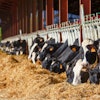
Management during the transition period has a substantial impact on subsequent dairy cow performance and getting it wrong can result in a myriad of problems.
Metabolic and other transition-related disorders present significant costs for dairy farmers. In addition to costs associated with treatment, the loss of milk and subsequent reduced fertility, affected cows are more likely to be culled. Negative impacts on health and fertility create issues with longevity, which further compounds the effect on bottom line.
It is reported that 25% of dairy cows culled over the year, leave the herd during the first 60 days of lactation. Most occur around calving and are often the result of issues with dry period management relating to nutrition, as well as cow comfort. These common disorders do not stand alone and often occur together. The main disorders are: Ketosis and fatty liver, hypocalcaemia and milk fever, retained placenta, metritis, displaced abomasum and mastitis.
Proper nutrition and cow management work to mitigate the risk of metabolic disease in transition cows.
Nutrition strategies to reduce the risk
The risk of occurrence of all of the above can be significantly reduced by appropriate management, particularly during the dry and transition period. However, many of the individual strategies focus on nutrition during the transition period. The importance of a balanced ration at any stage of production is well-accepted, but there are specific practices that can contribute to metabolic health. Physiological stress is the adaptation of the body’s functions to try to cope with the current situation, e.g., calving. Certain processes occur leading up to and during calving that allow the animal to cope with what is happening. Hence, optimal nutrition is vital to avoid exacerbating the situation. Both deficiencies and excesses of various nutrients can result in impaired immune function, so careful attention must be paid to transition cow diets.
Minimizing negative energy balance (NEB) immediately post-calving will help reduce problems, such as ketosis and fatty liver. Maintaining appropriate body condition throughout the dry period and ensuring cows don’t calve down in excess body condition will go a long way to achieving that goal. Producers should aim for 90% of cows to meet a target body condition score (BCS) of 3.0 to 3.25 at drying off, which should occur six to eight weeks before calving. They need to remain at this score throughout the dry period and, ideally, calve down at the same condition score they dried off at. Overweight and underweight cows are both problematic; however, changes to BCS should be avoided during the dry period if possible.
A condition exceeding a score of 3.50, or if there is a gain of more than 0.25, increases the risk of ketosis. For cows in poor body condition during late lactation, consider drying off two weeks early and feeding for some condition gain.
Animals with an NEB tend to have elevated levels of compounds associated with an increase in inflammatory conditions and mobilization of body fat to provide additional energy, which has detrimental effects on metabolism, as well as the immune system. One study highlighted the reduction in cell membrane concentrations of the polyunsaturated fatty acids (PUFA), eicosapentaenoic acid (EPA) and docosahexaenoic acid (DHA) due to a shift in the profile of circulating fatty acids (FA). PUFA are also the precursors for many compounds, such as eicosanoids, prostaglandins, leukotrienes and thromboxanes, which are all involved in the immune response.
Eicosanoids show varying degrees of inflammatory stimulation, and, thus, alterations in FA profiles due to NEB will influence the inflammatory response. Minimizing the mobilization of body fat is the key target for reducing cases of ketosis and fatty liver. Additionally, promoting DMI and roughage intake will also aid in preventing DAs. Only forage of good hygienic quality should be offered to these animals, given they are already somewhat immune-compromised.
Energy, vitamins and minerals
Content, as well as type of dietary energy supply, is important with regards to reducing the amount of body tissue a cow needs to mobilize in order to meet demand. Feeding grain during the close-up period and partially introducing the animals to the lactation ration is often practiced not only to close the gap between energy supply and demand but also to avoid an abrupt change of diet, which compromises the rumen. However, excessive grain feeding will cause more issues, e.g., acidosis, than it solves with regards to rumen function, so a balance needs to be struck. Fat is often used to increase energy density, but it must not be at the expense of ration balance. Avoidance of excess dietary protein should be taken into account when formulating rations and the cow should be provided with optimal levels of forage to minimize the risk of digestive disturbances.
This is particularly important during calving or at times of physiological stress, as the cow may have a sudden requirement for increased levels of minerals. Because inorganic forms cannot be stored, they don’t provide the reserves that need to be mobilized during times of increased need. This can result in a drop-in immunity and an increase in the occurrence of metabolic diseases.
Producers must keep accurate records on health problems around calving, including exactly when they occurred. This can prove valuable when producers are planning changes to the management and nutrition of their dry cows, as it can help indicate the likely cause of problems and, therefore, where improvements can be made in the future.
There has been much research on antioxidants in dairy cattle, including vitamins E, A and D, as well as selenium. Vitamin E is a membrane-bound antioxidant that works together with selenium to scavenge free radicals and peroxides. As well as an antioxidant, Vitamin E also has specific effects on macrophages. The relationship between Vitamin E and selenium, as well as levels of potential oxidants and compounds susceptible to oxidation, e.g., dietary unsaturated fatty acids, dictates requirements. It is well-accepted that selenium is a crucial antioxidant that works in tandem with vitamin E and has a major impact on oxidative stress. Selenium-containing enzymes, such as glutathione peroxidase, scavenge compounds that enhance oxidative stress and also have a vitamin E-sparing effect. Levels of selenoenzymes are known to decrease during the very late dry period but rapidly increase again in early lactation. Selenium inadequacy is linked with adverse immune function effects, such as impaired antibody production. Adequate selenium status has a positive effect on the animal’s ability to resist infection, as well as fertility parameters.
Zinc deficiency can result in immune abnormalities and, subsequently, greater vulnerability to infections. A decrease in lymphocyte proliferation, as well as reduced phagocytotic activity, has been demonstrated following zinc deficiency. Interestingly, disruption of immune function has also been noted following an excess of zinc, which highlights the possible role of zinc in immune regulation. Zinc is also crucial for maintaining the integrity of the primary barrier, the skin. Cells involved in the innate response require zinc for normal function and development. Copper is also crucial for immune function. It affects the interleukin responsible for T-cell proliferation in the adaptive response. Neutrophil proliferation is also affected by copper deficiency. Hence, copper-deficient animals often show immunosuppression.
General management
Nutrition is probably the most influential and most often considered when looking at management practices to address metabolic issues, but cow comfort and hygiene are also crucial. Genetics plays a role concerning susceptibility and selection of bulls, and breeding lines can go some way to helping reduce the risk further. Minimizing the incidence of metabolic diseases and, therefore, impact on efficiency of the herd should be a holistic approach combining management, the environment and nutrition. Cow comfort and minimal stress (both environmental and physiological) should be inbuilt into transition period management. Adequate space and a clean, dry, well-ventilated housing area are important, and allowing very close-up and freshly calved cows to be close to the lactating herd will reduce stress.
Ultimately, metabolic disorders are interrelated and the occurrence of one increases the risk of others. Prevention is, as always, better than cure and many management strategies exist to reduce the risk of disease and cost.
References available on request.














